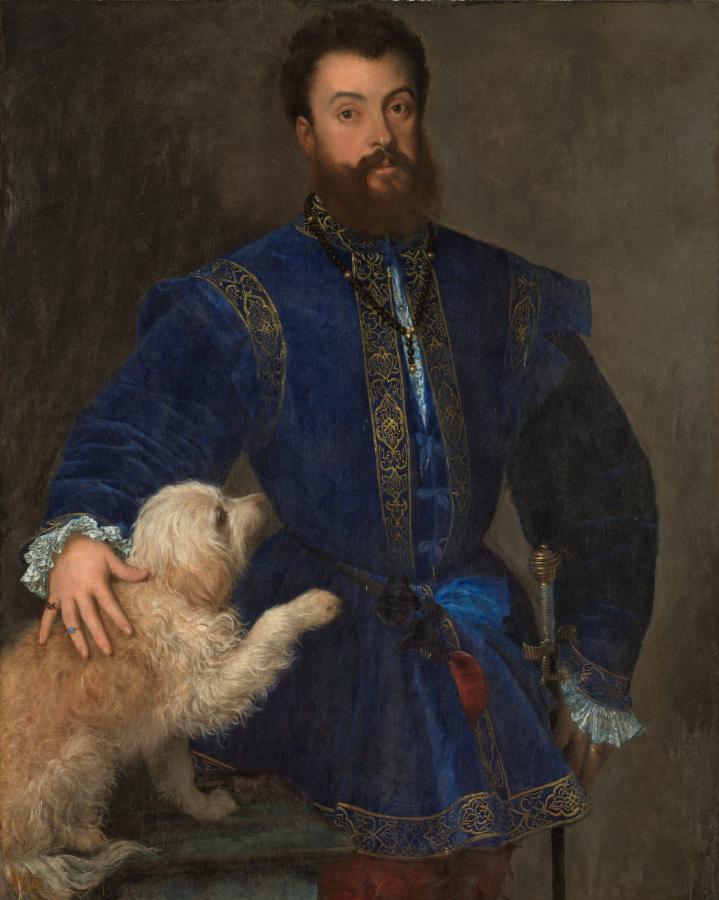Tiziano (c.1488-1576)
Ritratto di Federico II Gonzaga (Portrait of Federico II Gonzaga)
1529
Oil on panel, 125 x 99 cm
Museo del Prado, Madrid
On 16 April 1529 Federico II Gonzaga, First Duke of Mantua (1500-1540), apologised to his uncle Alfonso d’Este for retaining Titian: ‘perché ha conienzo un retratto mio qual molto desidero sii finito’ (because he has started a portrait of me which I greatly desire to be finished). In 1530 a second portrait of Federico in armour is also recorded. Typologically and conceptually, the present portrait of Federico is notably similar to the one of his uncle Alfonso I d’Este painted by Titian around 1523–1525 and known through copies (New York, Metropolitan Museum of Art). These early court portraits offered the painter new challenges which he resolved through the adoption of an innovative three-quarter format, a use of exquisite detail in the recreation of the texture of the clothing (which were not subject to Venetian sumptuary laws), and the inclusion of elements alluding to the sitter’s social rank or personal abilities. Examples of the latter include the cannon in the portrait of Alfonso, who was an expert on artillery, and the dog in Federico’s, as the Duke was known for his love of these animals. The pose of the two aristocrats is also identical, with the left hand on the sword and the right resting on an object (in the case of Alfonso) or an animal (Federico). The portrait of Federico also bears similarities to that of Laura Dianti, the lover of Alfonso d’Este (Kreuzlingen, Heinz Kisters Collection), both in its three-quarter format and particularly with regard to the spectacular use of ultramarine blue in the clothing. In the portrait of Laura Dianti the position of the little dog is occupied by a black servant, both of which are the object of affection on the part of their owners. Federico wears red hose and a doublet of blue velvet with gold embroidery, and from his neck hangs a costly gold and lapis lazuli rosary. He rests his left hand on the pommel of his sword while the right, adorned with two precious rings, caresses a Maltese dog. Although a dog of this type might seem to be more appropriate as a symbol of fidelity for female portraits than for masculine ones, in which larger dogs were usually depicted, its inclusion here, like the rosary, is not incidental. The portrait has been related to Federico’s matrimonial intentions in 1529 and the need to whitewash his dissolute past. The portrait, in which he is shown as affable and pious while retaining his aristocratic dignity, would thus form part of this strategy, which was brought to a successful conclusion with his marriage in 1531 to Margherita Paleologa, heiress of the Marquis of Monferrato. The present work is an outstanding example of the triumph of art and the power of the portrait. More important than the dog’s breed is its participative pose that makes it comparable to the fawning, adoring dogs of classical poetry who recognise the image of their master. This is similar to the way in which the young grandson gives life to the dead grandfather in the portrait by Domenico Ghirlandaio, a work that can be considered the greatest homage to the illusionistic and empathetic powers of painting. (Museo Nacional del Prado, El retrato del Renacimiento, Madrid, Museo Nacional del Prado, 2008, p.215/216)
See also:
• Federico II Gonzaga, 1st Duke of Mantua (1500-1540)
